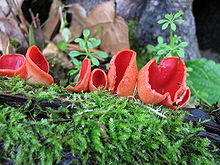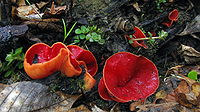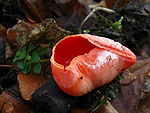Sarcoscypha coccinea
| Sarcoscypha coccinea | |
|---|---|

| |
| Scientific classification | |
| Domain: | Eukaryota |
| Kingdom: | Fungi |
| Division: | Ascomycota |
| Class: | Pezizomycetes |
| Order: | Pezizales |
| Family: | Sarcoscyphaceae |
| Genus: | Sarcoscypha |
| Species: | S. coccinea
|
| Binomial name | |
| Sarcoscypha coccinea (
Scop.) Lambotte (1889) | |
| Synonyms[1] | |
|
List
| |
| Sarcoscypha coccinea saprotrophic | |
|---|---|
| Edibility is edible | |
Sarcoscypha coccinea, commonly known as the scarlet elf cup, or the scarlet cup, is a species of
The
Taxonomy, naming, and phylogeny
The species was originally named Helvella coccinea by the Italian naturalist Giovanni Antonio Scopoli in 1772.[2] Other early names include Peziza coccinea (Nikolaus Joseph von Jacquin, 1774)[3] and Peziza dichroa (Theodor Holmskjold, 1799).[4] Although some authors in older literature have applied the generic name Plectania to the taxon following Karl Fuckel's 1870 name change[5] (e.g. Seaver, 1928;[6] Kanouse, 1948;[7] Nannfeldt, 1949;[8] Le Gal, 1953[9]), that name is now used for a fungus with brownish-black fruit bodies.[10] Sarcoscypha coccinea was given its current name by Jean Baptiste Émil Lambotte in 1889.[1]

Obligate synonyms (different names for the same species based on one type) include Lachnea coccinea Gillet (1880),[11] Macroscyphus coccineus Gray (1821),[12] and Peziza dichroa Holmskjold (1799). Taxonomic synonyms (different names for the same species, based on different types) include Peziza aurantia Schumacher (1803), Peziza aurantiaca Persoon (1822), Peziza coccinea Jacquin (1774), Helvella coccinea Schaeffer (1774), Lachnea coccinea Phillips (1887), Geopyxis coccinea Massee (1895), Sarcoscypha coccinea Saccardo ex Durand (1900), Plectania coccinea (Fuckel ex Seaver), and Peziza cochleata Batsch (1783).[13]
Sarcoscypha coccinea is the
S. coccinea var. jurana was described by Jean Boudier (1903) as a variety of the species having a brighter and more orange-colored fruit body, and with flattened or blunt-ended ascospores.[19] Today it is known as the distinct species S. jurana.[20] S. coccinea var. albida, named by George Edward Massee in 1903 (as Geopyxis coccinea var. albida), has a cream-colored rather than red interior surface, but is otherwise identical to the typical variety.[21]
| |||||||||||||||||||||||||||||||||
| Phylogeny and relationships of S. coccinea and related species based on ITS sequences and morphological characteristics.[22] |
Within the large area that includes the temperate to alpine-boreal zone of the Northern Hemisphere (Europe and North America), only S. coccinea had been recognized until the 1980s. However, it had been known since the early 1900s that there existed several macroscopically indistinguishable taxa with various microscopic differences: the distribution and number of oil droplets in fresh spores; germination behavior; and spore shape. Detailed analysis and comparison of fresh specimens revealed that what had been collectively called "S. coccinea" actually consisted of four distinct species: S. austriaca, S. coccinea, S. dudleyi, and S. jurana.[23]
The
Description
Initially spherical, the fruit bodies are later shallowly saucer- or cup-shaped with rolled-in rims, and measure 2–6 cm (0.8–2.4 in) in diameter.[18][25] The inner surface of the cup is deep red (fading to orange when dry) and smooth, while the outer surface is whitish and covered with a dense matted layer of tiny hairs (a tomentum). The stipe, when present, is stout and up to 4 cm (1.6 in) long (if deeply buried) by 0.3–0.7 cm (0.1–0.3 in) thick, and whitish, with a tomentum.[18] Color variants of the fungus exist that have reduced or absent pigmentation; these forms may be orange, yellow, or even white (as in the variety albida). In the Netherlands, white fruit bodies have been found growing in the polders.[26]

Sarcoscypha coccinea is one of several fungi whose fruit bodies have been noted to make a "puffing" sound—an audible manifestation of spore-discharge where thousands of asci simultaneously explode to release a cloud of spores.[27]
The asci are long and cylindrical, and taper into a short stem-like base; they measure 300–375 by 14–16 µm.[7] Although in most Pezizales all of the ascospores are formed simultaneously through delimitation by an inner and outer membrane, in S. coccinea the ascospores located in the basal parts of the ascus develop faster.[30] The paraphyses (sterile filamentous hyphae present in the hymenium) are about 3 µm wide (and only slightly thickened at the apex), and contain red pigment granules.[31]
Anamorph form
Anamorphic or
Similar species
Similar species include S. dudleyi and S. austriaca, and in the literature, confusion amongst the three is common.[29] Examination of microscopic features is often required to definitively differentiate between the species. Sarcoscypha occidentalis has smaller cups (0.5–2.0 cm wide), a more pronounced stalk that is 1–3 cm long, and a smooth exterior surface.[35] Unlike S. coccinea, it is only found in the New World and in east and midwest North America, but not in the far west. It also occurs in Central America and the Caribbean.[36] In North America, S. austriaca and S. dudleyi are found in eastern regions of the continent. S. dudleyi has elliptical spores with rounded ends that are 25–33 by 12–14 µm and completely sheathed when fresh. S. austriaca has elliptical spores that are 29–36 by 12–15 µm that are not completely sheathed when fresh, but have small polar caps on either end.[37] The Macaronesian species S. macaronesica, frequently misidentified as S. coccinea, has smaller spores, typically measuring 20.5–28 by 7.3–11 µm and smaller fruit bodies—up to 2 cm (0.8 in) wide.[38]
Other similar species include Plectania melastoma, Plectania nannfeldtii, and Scutellinia scutellata.[25]
Ecology, habitat and distribution
A
Common over much of the Northern Hemisphere, S. coccinea occurs in the
Chemistry

The red color of the fruit bodies is caused by five types of
Uses
Sarcoscypha coccinea was used as a medicinal fungus by the
The species is said to be edible,[18][25] inedible,[55] or "not recommended",[43] depending on the author. Although its insubstantial fruit body and low numbers do not make it particularly suitable for the table, one source claims "children in the Jura are said to eat it raw on bread and butter; and one French author suggests adding the cups, with a little Kirsch, to a fresh fruit salad."[56][57] The fruit bodies have been noted to be a source of food for rodents in the winter, and slugs in the summer.[42]
References
- ^ a b "Sarcoscypha coccinea (Scop.) Lambotte 1889". MycoBank. International Mycological Association. Retrieved 2010-08-21.
- ^ Scopoli JA. (1772). Flora carniolica (in Latin). Vol. 2 (2 ed.). Vienna, Austria: Sumptibus J.T. Trattner. p. 479.
- ^ Jacquin NJ. (1774). Flora Austriaca. Vol. 2. Vienna, Austria. p. 40.
- ^ Holmskjold T. (1799). Beata ruris otia fungis danicis (in Latin). Vol. 2. p. 20.
- ^ Fuckel L. (1870). "Symbolae mycologicae. Beiträge zur Kenntnis der rheinischen Pilze" [Contributions to the knowledge of mushrooms of the Rhein]. Jahrbücher des Nassauischen Vereins für Naturkunde (in German). 23–24: 324.
- ^ a b Seaver FJ. (1928). The North American Cup-Fungi (Operculates). New York, New York: Self published. pp. 191–2.
- ^ JSTOR 3755155.
- ^ Nannfeldt JA. (1949). "Contributions to the microflora of Sweden. 7. A new winter Discomycete, Urnula hiemalis Nannf. n. sp., and a short account of the Swedish species of Sarcoscyphaceae". Svensk Botanisk Tidskrift. 43: 468–84.
- ^ Le Gal M. (1953). "Les Discomycètes de Madagascar" [The Discomycetes of Madagascar]. Prodrome à Flore Mycologique de Madagascar et Dépendanes (in French). 4. Paris, France: Muséum National d’Histoire Naturelle: 1–465.
- ^ JSTOR 1223069.
- ^ "Lachnea coccinea (Jacq.) Gillet 1880". MycoBank. International Mycological Association. Retrieved 2010-08-21.
- ^ "Macroscyphus coccineus (Scop.) Gray 1821". MycoBank. International Mycological Association. Retrieved 2010-08-21.
- ^ "Peziza dichroa Holmsk. 1799". MycoBank. International Mycological Association. Retrieved 2010-08-21.
- ^ Korf and Harrington (1990), citing Clements FE; Shear CL. (1931). The Genera of Fungi. New York, NY.
{{cite book}}: CS1 maint: location missing publisher (link) - ^ von Martius CFP. (1817). Flora Cryptogamica Erlangensis (in Latin). Nuremberg, Germany: J.L. Schrag. p. 469.
- ^ ISBN 978-0-395-91090-0.
- ISBN 978-1-84330-891-1.
- ^ ISBN 978-0-89815-169-5.
- ^ Boudier E. (1903). "Note sur quelques ascomycètes du Jura" [Notes on some ascomycetes of Jura]. Bulletin de la Société Zoologique de France (in French). 19: 193–9.
- ^ "Species synonymy: Sarcoscypha jurana (Boud.) Baral". Index Fungorum. CAB International. Archived from the original on 2011-06-10. Retrieved 2010-08-22.
- ^ Massee G. (1892). British Fungus-Flora. A Classified Text-Book of Mycology. Vol. 4. London, UK: George Bell & Sons. p. 378.
- ^ JSTOR 3761299.
- ^ a b Baral HO. (1984). "Taxonomische und ökologische Studien über Sarcoscypha coccinea agg., Zinnoberrote Kelchbecherlinge. (Kurzfassung)" [Taxonomic and economic study on Sarcoscypha coccinea]. Zeitschrift für Mykologie (in German). 50 (1): 117–46.
- ^ JSTOR 3761080.
- ^ OCLC 797915861.
- ^ Van Duuren Y; Van Duuren G. (2005). "Witte Rode kelkzwammen en op excursie met Hans-Otto Baral" [White Sarcoscypha coccinea fruitbodies and a foray with Hans-Otto Baral] (PDF). Coolia. 48 (3): 169–70.
- ^ Buller, 1958, pp. 329–31. Retrieved 2010-08-22.
- ISBN 978-0-520-03660-4.
- ^ a b c Harrington FA. (1990). "Sarcoscypha in North America (Pezizales, Sarcoscyphaceae)". Mycotaxon. 38: 417–58.
- ^ Merkus E. (1976). "Ultrastructure of the ascospore wall in Pezizales (Ascomycetes)—IV. Morchellaceae, Helvellaceae, Rhizinaceae, Thelebolaceae, and Sarcoscyphaceae. General discussion". Persoonia. 9: 1–38.
- ISBN 978-0-89054-107-4.
- ^ Molliard M. (1904). "Forme conidienne de Sarcoscypha coccinea (Jacq.) Cooke. Bull" [Condidial form of Sarcoscypha coccinea (Jacq.) Cooke. Bull]. Bulletin Trimestriel de la Société Mycologique de France (in French). 20: 138–41.
- ^ Paden JW. (1972). "Imperfect states and the taxonomy of the Pezizales". Persoonia. 6: 405–14.
- doi:10.1139/b84-035.
- ISBN 978-0-7627-3109-1.
- ^ JSTOR 3757876.
- ^ Kuo M. (2012). "Sarcoscypha dudleyi & Sarcoscypha austriaca". MushroomExpert.Com. Retrieved 2016-03-22.
- ^ Korf RP; Zhuang W-Y. (1991). "A preliminary Discomycete flora of Macaronesia: part 11, Sarcoscyphineae". Mycotaxon. 40: 1–11.
- ^ Kuo M. (2006). "Sarcoscypha coccinea". MushroomExpert.com. Retrieved 2016-03-22.
- ^ Baral HO. (2004). "Host specificity, plant communities". The European and North-American species of Sarcoscypha. Retrieved 2010-08-22.
- ISSN 0133-9095.
- ^ .
- ^ ISBN 978-0-472-85610-7.
- ISBN 978-0-7006-0571-2.
- ISSN 0187-3180.
- S2CID 85152759.
- ISBN 962-201-556-5.
- .
- ^ Baral HO. (2004). "Geographical Distribution". The European and North-American species of Sarcoscypha. Retrieved 2016-03-22.
- ^ Çinar H; Sermenli HB; Işiloğlu M. (2014). "Some critically endangered species From Turkey" (PDF). Fungal Conservation (4): 26–28.
- ^ Arpin N. (1968). "Les caroténoïdes des Discomycètes: essai chimiotaxinomique" [Carotenoids of the Discomycetes: chemotaxonomic analysis]. Bulletin Mensuel de la Société Linnéenne de Lyon (in French). 28 (Suppl): 1–169.
- ^ Buller, 1958, p. 301. Retrieved 2010-08-22.
- PMID 16566135. Archived from the original on 2011-08-31.)
{{cite journal}}: CS1 maint: bot: original URL status unknown (link - ISBN 978-0-442-21998-7.
- ISBN 978-1-84537-271-2.
- ^ "Pezize (in French, original recipe on Kirsch liquor and Grand Marnier blend with S. coccinea)". Supertoinette. Retrieved 2017-05-02.
- ISBN 978-0-19-280681-9.
Cited books
- Buller AHR. (1958). Researches on Fungi. Vol. 6. New York, New York: Hafner Publishing.


